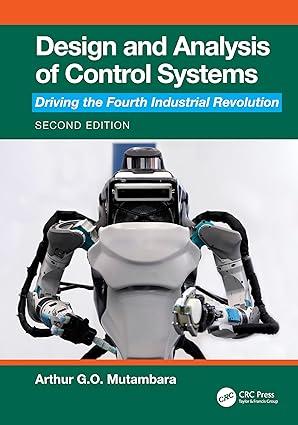The differential equation describes a DC motor speed control [dot{y}+60 y=600 v_{a}-1,500 omega,] where (y(t)) is the
Question:
The differential equation describes a DC motor speed control
\[\dot{y}+60 y=600 v_{a}-1,500 \omega,\]
where \(y(t)\) is the motor speed, \(v_{a}(t)\) is the armature voltage, and \(\omega(t)\) is the load torque. Assume the armature voltage is computed using the PI control law
\[K_{P}[r(t)-y(t)]+K_{I} \int_{0}^{t}[r(t)-y(t)] d t\]
where \(r(t)\) is the reference motor speed.
(a) Derive a block diagram representation of the system.
(b) (i) Compute the transfer function from \(r(t)\) to \(y(t)\) when \(\omega(t)=0\).
(ii) What is the steady-state error due to a ramp reference motor speed, \(r(t)=t\) ?
(iii) Deduce the system type with respect to the reference input \(r(t)\).
(c) (i) Compute the transfer function from \(\omega(t)\) to \(y(t)\) when \(r(t)=0\).
(ii) What is the steady-state error due to a disturbance input of the form \(\omega(t)=t\) ?
(iii) Deduce the system type with respect to the disturbance \(\omega(t)\).
(d) For the transfer function in (b) (i), compute the values for \(K_{P}\) and \(K_{I}\) so that the characteristic equation of the closed-loop system will have roots at \(-60 \pm 60 j\).
(e) Using the computed values of \(K_{P}\) and \(K_{I}\), derive the system's natural response due to the transfer function from \(\omega(t)\) and \(y(t)\).
(f) Verify the solutions to parts b (ii), c (ii), and (e) using MATLAB.
Step by Step Answer:

Design And Analysis Of Control Systems Driving The Fourth Industrial Revolution
ISBN: 9781032718804
2nd Edition
Authors: Arthur G O Mutambara





